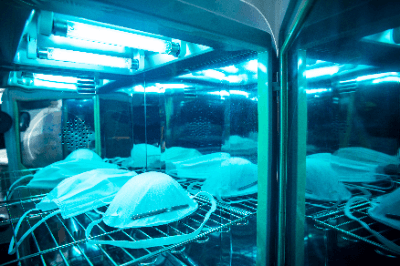What Is a UV Light Source?
 A UV light source is a device that emits ultraviolet (UV) light.
A UV light source is a device that emits ultraviolet (UV) light.
In addition to the light source that generates the UV light, some commercially available UV light sources include a cooling system and an optical system that converts the UV light into a linear beam through a lens for easy use. The ultraviolet light emitted by each type differs.
There are three types of light sources, which are distinguished into “high-pressure mercury type” which emits ultraviolet rays with a wavelength of 365 nm (nanometers), “metal halide type” which emits ultraviolet rays from 200 to 400 nm, and “low-pressure mercury type lamps” that oscillate with a wavelength of 254 nm and 185 nm. The type of UV light source that can be irradiated has a great deal to do with the function of the equipment, and the UV light source must be selected according to the purpose.
High-intensity UV light source is equipped with a cooling system because the equipment itself becomes hot. Care must be taken when handling them, as they may emit ozone with an unusual odor or decompose organic matter in the surroundings when in use.
Uses of UV Light Sources
Different UV light sources are used for different purposes. Usage applications by type are as follows:
1. High-Pressure Mercury Lamps
Often used for curing UV resins and paints.
2. Metal Halide Lamps
Metal halide lamps are used for resins and paints cured by short-wavelength ultraviolet rays. Compared to high-pressure mercury lamps, metal halide lamps have a higher total energy when curing UV resins and paints because the UV rays emitted are continuous wavelength.
3. Low-Pressure Mercury Type Lamps
The short wavelength of 254nm is used for UV sterilization, etc. The multiple wavelengths of 254nm/185nm are used for antioxidant treatment of water and UV cleaning in addition to sterilization. They also generate ozone, which can be used to clean organic matter adhering to silicon substrates, etc. However, prolonged use of the system will cause an oxide film to form, so a tidal range is necessary.
Principle of UV Light Sources
UV light sources are devices that emit ultraviolet rays through the discharge of gaseous mercury, which is contained in a glass tube with electrodes at both ends, filled with mercury (Hg) and a noble gas.
An electric current applied to the electrodes generates heat energy inside. The emitter (electron-emitting material) emits electrons due to the thermal energy, and the electrons move in one direction between the electrodes. During this movement, the electrons collide with the Hg molecules inside, and the Hg molecules emit ultraviolet radiation due to the impact.
As the ultraviolet rays pass through the glass, they come into contact with and are absorbed by the fluorescent material coated on the glass, which changes the wavelength and irradiates them as ultraviolet rays of the desired wavelength. In other words, the wavelength of the ultraviolet light is determined by the glass material and the fluorescent material coated on the glass.
High-pressure Hg lamps and metal halide lamps use quartz glass, while low-pressure Hg lamps use synthetic quartz glass. The wavelength of low-pressure Hg lamps can be further varied depending on whether ozone is sealed inside the lamps.
Other Information on UV Light Sources
1. Led UV Light Sources
Incandescent and fluorescent lamps have been replaced by LEDs for more than 10 years. However, as mentioned above, mercury-based UV light sources are still widely used.
One of the factors hindering the shift to LED UV light sources is the low output power and long working hours required for curing resins and drying inks and paints. However, thanks to the efforts of LED light source manufacturers, high-power LED (UV) light sources have recently become available.
Replacing conventional UV light sources with LED light sources has the advantages of reduced power consumption, which reduces electricity costs, and reduced light source replacement due to long life and minimal deterioration caused by turning the power on and off. In addition, since UV light sources, UV lamps, use mercury, there is a great merit in switching to LED light sources from the viewpoint of reducing the amount of mercury used. Mercury is harmful to the human body and the environment.
2. Causes of UV Light Sources Not Curing UV
UV light sources are sometimes used to cure resins, but depending on the conditions of use, the environment, and the combination of resin materials, the resin may not harden. The main causes are listed below.
High Humidity
Depending on the combination of materials and curing agents, the resin curing speed may be significantly reduced in high humidity. If work must be performed in such an environment, the use of additives may improve the situation.
Wavelengths Do Not Match.
For each material or curing agent, there is an optimal UV wavelength to irradiate for curing. Check the specifications of the material or curing agent and confirm that the optimal light source is being used.
Light Source Output Is Insufficient.
Insufficient output of the LED light source may result in light not reaching deep into the material and curing may not take place. The same settings as with mercury lamps may not be used for proper curing, and therefore, some ingenuity is required when changing the light source, etc.